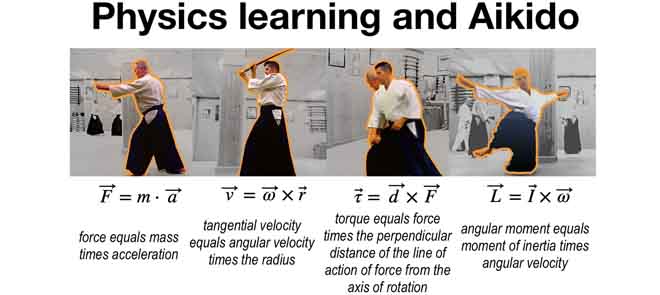Phy+Aik (Physics + Aikido) is a proposal to design an intelligent psychomotor system for a STEAM (Science, Technology, Engineering, Arts and Mathematics) kinesthetic learning scenario to support the learning of Physics with the practice of Aikido.
Aikido, considered a defense martial art, is a soft style martial art and thus, it relies on circular movements that contribute to reuse the force of the attacker against herself. For this reason, it can be then used to study both rectilinear (from attacking-like movements) and curvilinear (from defensive-like movements).

With Phy+Aik, we propose a sensor-based framework where educators can produce innovative visual educational material for teaching Physics that is obtained with optical tracking devices and then synchronized and tagged with inertial data collected with wearable sensors from the linear and twisted displacements performed by Aikido practitioners.

To evaluate the benefits of this proposal, a user study has been carried out, where Aikido practitioners performed different techniques. The goal of the study was to determine if students watching the execution of those techniques can enhance their understanding of diverse physics concepts. This is related to the process of restructuring prior knowledge (also referred to as ‘conceptual change’), which is especially relevant when learning complex physics concepts.


The added value of using martial arts is that they are built on codified movements for combat and self-defense training. The perfection of the basic techniques is the prime objective of martial artists who should practice over and over for years to master a set of precise movements. Training requires sequential repetition of prearranged movements until their performance becomes nearly automatic. This provides a useful scenario to research on human movement computing.
In fact, in the context of Phy+Aik, we have also done some efforts to model some Aikido movements from data collected with inertial sensors, aimed to determine if the practitioner is a novel or an expert practicant. For this, we have proposed the intelligent expertise level assessment approach (iELA).
Selected references:
O. C. Santos & A. Corbi (2019), “Can aikido help with the comprehension of physics? A first step towards the design of intelligent psychomotor systems for STEAM kinesthetic learning scenarios”, IEEE Access, vol. 7, pp. 176458–176469.
A. Corbi, O. C. Santos, & D. Burgos (2019), “Intelligent framework for learning physics with aikido (martial art) and registered sensors”, Sensors (Basel), vol. 19, núm. 17, p. 3681.
A. Corbí & O. C. Santos (2018), “MyShikko: Modelling knee walking in aikido practice”, en Adjunct Publication of the 26th Conference on User Modeling, Adaptation and Personalization.